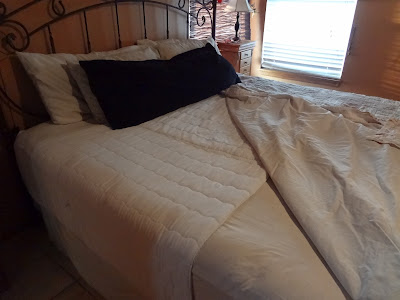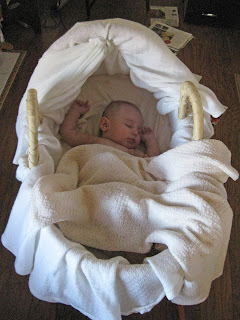Materials:
1/3 yd cotton print for outer cover
1/3 yd cotton print for liner
1" velcro
1/3 yd fusible interfacing
1. Measure the size of your pad, accounting for width and add 3/4" on the top, bottom and one side for seam allowances.
2. Cut out a rectangle from your liner fabric large enough to fold over the pad like a book, again accounting for width and 3/4" seam allowances all the way around. (You'll see in the picture that I only did 1/2" seam allowance. You'll need the extra 1/4" at the end when you top stitch. I fudged by pulling up the stitching over the corners so I can still fit in the pad, but it doesn't look quite as nice.)
3. Cut out a rectangle from your outer fabric the same size and the inner. Set aside.
4. Cut out 5 squares with 3" sides. Fold 4 of them in half diagonally and iron. Set aside.
5. Figure out how big your crayon pocket needs to be by laying your crayons side by side and measuring the width, depth, and how tall you want it. I'm using chunky dry erase crayons that are 1/2" diameter and all of them together were 4" across. So for the width, I took the 4", added an inch for the diameter on each side, then another inch and a 1/4 for seam allowances. For the height, I wanted it about 3" tall. I added 1" for seam allowances (though I think 1/2" would have worked better here) so my slip pocket rectangles came out to 6 1/4"x4". (I didn't allow enough width the first time. The picture shows my smaller version before I re-did it.)
6. Cut out a piece of interfacing the same size as your pocket rectangles and iron it on to the wrong side of either one.
7. With right sides together, stitch around the edges of the pocket with a 1/4" seam allowance, leaving just enough open to turn.
9. Turn the pocket right side out, turning in the open edges and iron. Place it about an inch from the right side of the liner, and sew it down as close the the edge of the pocket as you can. Mine was about a 1/4".
10. Fold the pocket back on the seam, iron, then fan fold it forward again. Fold the other side of the pocket to match and stitch into place.
11. Sew along the bottom of the pocket.
12. Add interfacing and Velcro to your outer fabric. Set aside.
(Center the Velcro on a short side, 1" in from the edge.)
13. Retrieve 4 of your 3" triangles and fold one side under slightly, tucking in the corner on two on them.
14. Place your triangles, on your cover, using your pad to measure placement. Your turned ends should end up in the middle of your cover liner. Remember I fudged and only left a 1/2" seam when there should have been 3/4" all the way around the pad.
15. Remove the pad, pin the corners in place, and place your outer fabric, right sides together on top of the liner, making sure the Velcro will be on the front, not the back like I did...
16. Starting at the end opposite the Velcro, sew all the way around with a 1/2" seam allowance, leaving just enough to turn and to insert a tab that will fold over to Velcro your cover closed.
17. Take your last 3" square and sew two sides, right sides together with a 1/4" seam allowance. Turn right side out and iron flat with the seam in the center.
18. Fold one end in about 1/2". Tuck the raw end into the opening on your cover and top stitch all the way around with a 1/4" seam allowance. (This is where I had to remove the top-stitching over the corner triangles because I couldn't fit the pad into the cover.)
19. Sew on the soft half of the Velcro to the tab, lining it up with the rough side on the cover.
20. Watch two year old immediately take everything apart while you are trying to photograph the finished product...

This post has been included in Teach me Tuesday, Anti-Procrastination Tuesday, Morristribe's Homesteader Blog Carnival and The Homestead Barn Hop.

















































